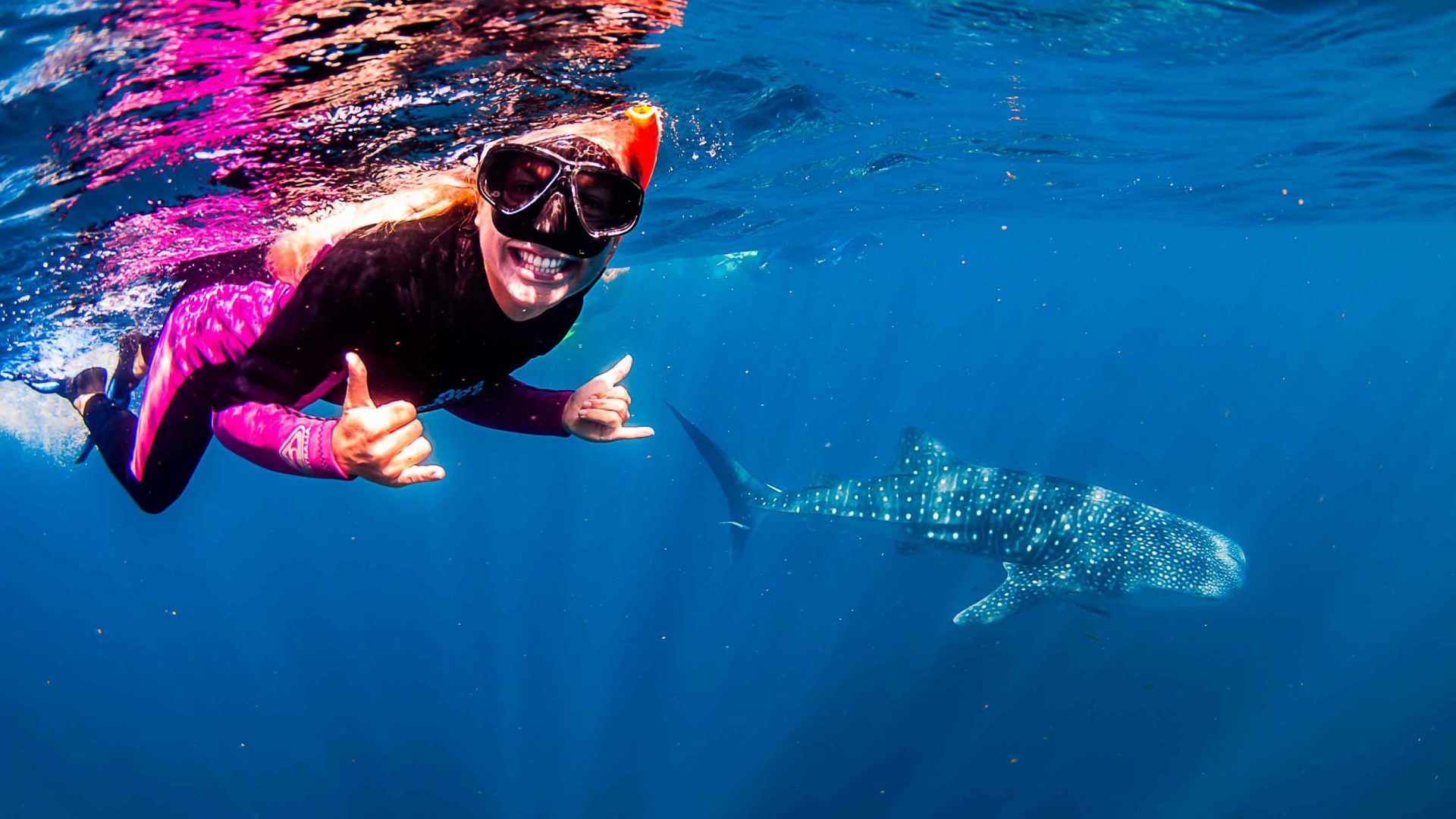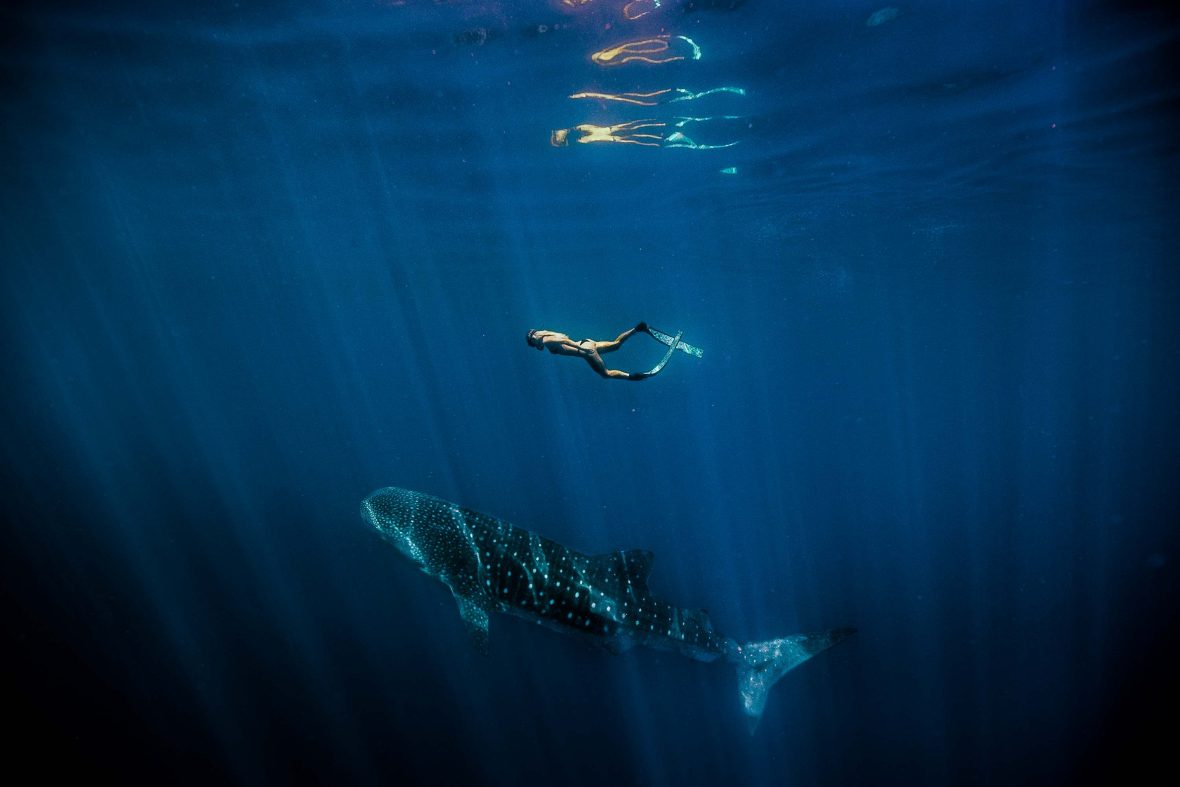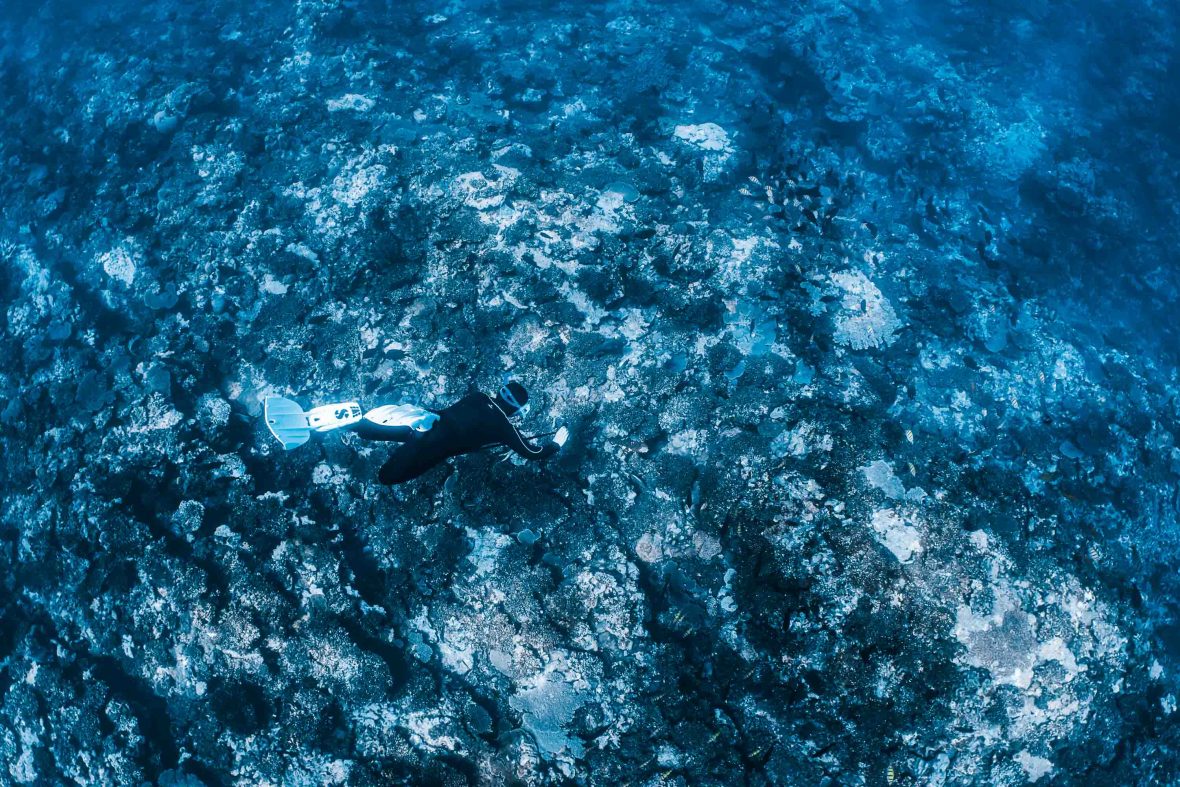
New research shows Western Australia sets the “gold standard” for whale shark tourism. Sarah Reid dives into Ningaloo Reef—and the science—to find out how it stacks up.


New research shows Western Australia sets the “gold standard” for whale shark tourism. Sarah Reid dives into Ningaloo Reef—and the science—to find out how it stacks up.
“Go, go, go!”
Slipping off the back of the boat into the cool, blue water on our snorkel guide Freya Scrowston’s signal, I find myself facing a five-meter (16-foot) whale shark, its elongated mouth agape to scoop up the planktonic goodness invisible to my human eyes. A distinctive checkerboard pattern of bright white spots adorns its sleek grey body, like a living Aboriginal artwork, and a posse of cleaner wrasse jostle for position on its vast white underbelly.
This otherworldly scene is unfolding at Australia’s World Heritage–listed Nyinggulu (Ningaloo) Reef, where the gin-clear waters of the Indian Ocean meet the arid Western Australian outback.
Between March and July each year, the abundance of naturally occurring food coinciding with the annual coral spawning attracts hundreds of whale sharks, mostly juvenile males, to the traditional Sea Country of the Baiyungu, Thalanyji and Yinigurdira peoples. Also gathering in Ningaloo each whale shark season is a steady stream of tourists keen to get a glimpse of this majestic megafauna in its natural habitat.

There’s a lot scientists still don’t know about whale sharks, including where they breed and give birth. But new technology is increasingly helping researchers to unravel the mystique of these creatures of the deep, which can dive to more than 2,000 meters (6,562 feet)—including the impacts of tourism on this species.
A recent study published in the Journal of Sustainable Tourism used biotelemetry devices—think of them as Fitbits for animals—for the first time to measure the activity of boats and snorkelers on whale sharks in Ningaloo. In an endorsement of tightly regulated local tourism practices, the research found that the impacts were next to none.
A maximum of 10 swimmers are allowed to swim alongside a shark at a time, and approaching a shark within three meters (10 feet) from the head (or four meters/13 feet from the tail) is forbidden.
“Ningaloo has always been held up as an example of how whale shark tourism should be conducted,” says study leader Dr Samantha Reynolds, a research scientist at ECOCEAN, Australia’s only not-for-profit whale shark research organization. “Our study has given scientific backing to these claims, and I hope that this will help other researchers who are working to try to encourage better practices at other tourism sites.”
Just 14 operators, including Exmouth Dive and Whale Sharks Ningaloo, who is hosting my day trip, are licensed to conduct whale shark tours in the 2435-square-kilometer (940-square-mile) Ningaloo Marine Park.
Interaction protocols implemented by the state’s Department for Biodiversity, Conservation and Attractions for vessels and swimmers are strict: Only one boat at a time may operate within 250 meters (820 feet) of a shark—additional vessels must stay 400 meters (1,312 feet away)—and the leading vessel must not approach within 30 meters (98 feet).
Not only that, but a maximum of 10 swimmers are allowed to swim alongside a shark at a time, and approaching a shark within three meters (10 feet) from the head (or four meters/13 feet from the tail) is forbidden. Flash photography and freediving around the sharks is also banned, and there’s no provisioning (feeding or baiting).
The rules are followed to the letter during my tour—by people at least—with the two groups of 10 tourists on our boat taking turns to swim with two separate sharks twice each during the day. When one shark decides to change direction on a whim, there’s a flurry of flippers as we scramble out of its way and reform a line alongside it.
But these brief moments of confusion pale in comparison to the chaotic scenes that have been documented at other whale shark tourism hotspots around the world such as the Maldives and the Philippines. While whale shark tourism in Oslob in the Philippines has been credited with lifting locals out of poverty, more than one study has highlighted a need for improved tourism management to ensure its sustainability.

But even “gold standard” whale shark tourism is arguably flawed.
“Making sure that the tourism encounters are not negatively impacting the target animals is just one aspect of ensuring that tourism is sustainable,” explains Reynolds. “Tourism operators, management and participants should also consider their effects on other species, the habitat and ecosystem, and the planet as a whole.”
“We have this hardwired fascination for this megafauna, and whale shark tourism is about stoking that fascination. That’s the thing that may mean that these animals actually survive through the 21st century.”
- Dr Mark Meakin, University of Western Australia
Worth considering before rushing to sign up for a whale shark swim in Ningaloo, for example, is the carbon cost.
Most visitors reach Ningaloo by plane (it’s a two-hour flight from Perth to the gateway town of Exmouth) and between the fuel burned by the boats and spotter planes used by operators to locate the sharks (which are notoriously difficult to spot from boats), it’s not exactly a carbon-light activity.
Listed as endangered by the IUCN Red List, whale sharks face a spectrum of threats, says Dr Mark Meakin, an adjunct Senior Research Fellow at the University of Western Australia who has been studying whale sharks since the mid-1990s.
“Climate change and ocean pollution, particularly plastics, are turning out to be a pretty big worry for these giants,” says Meakin, who is also using biotelemetry, as well as ultrasound imaging, to learn more about the health of whale sharks.
“We discovered that when we pick parasites off the sharks, which are like little black box recorders, they stop and go into a vertical position, like they’re at a cleaning station,” he adds. “This is an opportunity for us to look at the internal health of the animals.”

Healthy whale sharks are key to healthy marine ecosystems, Meakin tells me, adding that the species is thought to play an important role in the ocean’s biologically driven sequestration of carbon. “We think that they’re likely to be very important in supplying nutrients and retaining nutrients in these tropical surface waters, which planktonic systems can then rely on to kick-off.”
He firmly believes tourism is crucial to conserving these mesmerizing creatures: “We have this hardwired fascination for this megafauna, and whale shark tourism is about stoking that fascination. That’s the thing that may mean that these animals actually survive through the 21st century.”
Swimming alongside the biggest fish in the sea at Ningaloo, it’s impossible not to feel a deeper sense of responsibility to protect these beautiful beasts. But it’s even sweeter knowing for sure that my presence isn’t negatively impacting their natural rhythm.
*The writer visited Ningaloo as a guest of Tourism Western Australia (TWA). TWA did not review or approve this article.
***
Adventure.com strives to be a low-emissions publication, and we are working to reduce our carbon emissions where possible. Emissions generated by the movements of our staff and contributors are carbon offset through our parent company, Intrepid. You can visit our sustainability page and read our Contributor Impact Guidelines for more information. While we take our commitment to people and planet seriously, we acknowledge that we still have plenty of work to do, and we welcome all feedback and suggestions from our readers. You can contact us anytime at hello@adventure.com. Please allow up to one week for a response.








Can't find what you're looking for? Try using these tags: